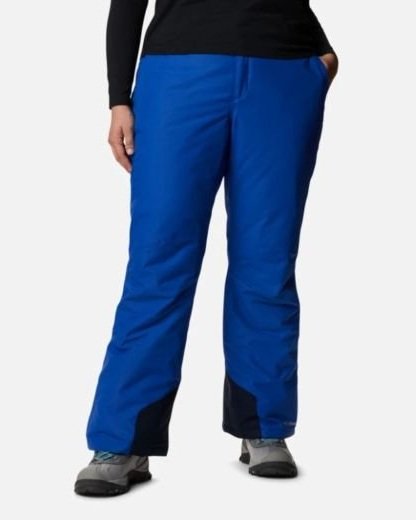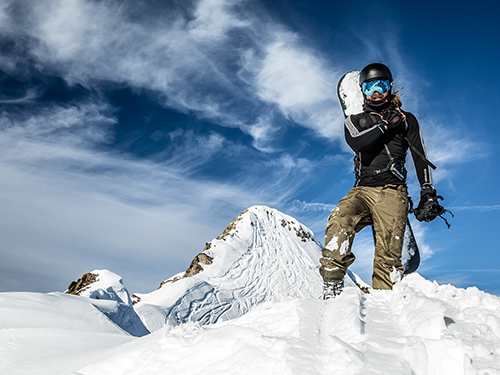
Overall snow pants provide a comfortable fit with a range of design options making them a popular choice for winter athletes. These pants are essential for any skier, regardless of whether you enjoy backcountry skiing or lift-assisted snowboarding.
All you need to know about overall snow pants
There are many aspects to consider when looking at snow pants. While your focus may be on the look of the garments it is important that you also consider comfort and body temperature.
Insulated Snow Pants
Some snow pants have a combination windproof and waterproof shell fabric, as well as insulation, to keep you warm in winter. These insulated ski/snowboard pants don't look as good as traditional shells, but they are an excellent choice for winter lovers who live in cold areas.
Patagonia’s Powder Town pants have a high-quality waterproof fabric and soft taffeta lines that provide next-toskin comfort. The pants also contain a thin layer of synthetic insulation, 60 grams in weight, to keep you dry and warmer when it's cold.

Cargo Snow Pants
Designed for snowboarders, cargo snow pants typically feature a range of zippered rear, cargo, and thigh pockets for stashing gear, snacks, and gloves. They can be bulky and restrict movement so we advise against packing them too full.
Pulse Winter Pants
A popular pick among snowboarders, pulse snow pants have a similar design to traditional snowboarding designs, but they include an extra layer of material above the waist for added warmth. This layer protects your bottom and wicks sweat, keeping you cool.
Pants with Reflective Snow Design
If you spend time outdoors in cold conditions, reflective snow pants are a good option. A layer of Lumentex(r), reflective tap can be added to make you stand out in low visibility conditions.
This reflective layer is designed for visibility on slopes and low-light conditions like snowy sled trails. A few models have a reflective strip at the knees and a belt that can be pulled up to enhance visibility.
Bibs
People who don’t need the protection that a baselayer provides will choose bibs instead of snow pants. This is because bibs are more comfortable and provide warmth. These bibs can be made from lightweight, breathable materials such as polyester or merino wool.

You might consider a bib that has a stronger construction and more features for heavier riders, such as a zippered handwarmer or cargo pocket. The bibs on this pair from Carhartt are especially well-made, as they're made from a heavyweight poly-wool blend that's quick to dry and fights odor.
Backcountry Snow Pants
Snowboarders and skiers will need to cope with some rain. To keep dry on the slopes, it is essential to have waterproof pants. Sidecountry skiers and those who work hard will prefer a shell. However, backcountry enthusiasts and those who plan to travel long distances can use bibs made of a flexible, stretchy, hardshell fabric to allow air to circulate around their knees and thighs.
FAQ
Are you worried about losing something while you're on the road?
Yes, I often forget stuff. This is most common on short trips. But I have everything with I, so I never run low.
I always keep my passport, for example. When I buy tickets, I always ensure that I have enough cash.
I also keep my phone charged. Also, I have a small bag that I store my other items in.
Where can I buy cheap airline tickets?
You can find the best deals on airfare by looking at airlines like Jetstar or Virgin Australia, Tigerair, Malaysia Airlines and Singapore Airlines.
Look online for cheap flight tickets.
What should you do the first time you arrive at your travel destination after you have arrived?
You should always have an itinerary for when you arrive at a place. This helps you to know what to expect and where you should go next.
It is important to plan ahead so you don't forget anything.
For instance, if your trip to a city lasts more than one hour, research which landmarks, museums, and parks you'd like.
Also, you may want to look into getting a map of the area and reading up on the region's history.
Statistics
- According to Maori legends, this park holds 14 fjords that were all carved by a giant stonemason with an adze. (busytourist.com)
- Between the ages of 11 and 13, kids, or tweens, will likely want some autonomy but also need boundaries. (travelandleisure.com)
- Alcoholic beverages with 24% alcohol or less are not subject to limitations in checked bags. (tsa.gov)
- You can use compression sacs or cubes to reduce the volume of your clothes by up to 80%—this is especially convenient for bulky items such as sweaters and jackets. (eaglecreek.com)
- That's an 18% jump from 2019, the previous record year. (travelandleisure.com)
External Links
How To
How to plan your next vacation
Planning a trip involves many things like booking flights, hotels, car rentals, activities, etc. It includes important considerations such a budget, destination, weather forecast, time frame, etc.
These are the things you should keep in mind as you plan your next vacation.
To ensure you get everything right, we have created a step-by-step guide to help you plan your next vacation. This guide has been compiled using customer feedback as well as our own experience. This guide will help you plan your next vacation easily.
Steps:
-
Plan your Budget - Planning your budget is one of the most important steps in preparing for a trip. Before you begin planning for your trip, you need to know how much money it is you are willing and able to spend. If you don't have the money, your plans may be cancelled.
-
Book Flights – After setting your budget, you must book your flights. Make sure you choose the best flight deal available at the lowest price. Also, check if airlines offer any special deals during certain seasons. These deals could be a great way to save money.
-
Choose Your Destination - Once you've booked your ticket, the next thing you'll need to decide is where you'd like to travel. Multiple factors come into play when choosing your destination, including location (where you're going), climate (what season to visit), culture (how friendly people are), and cost (how affordable it is).
-
Locate Accommodations – After you've chosen your destination, you need to locate accommodations. You have many accommodation options, from hostels and luxury suites to choose from. Choosing the right type of accommodation depends on your needs and preferences. A hotel is not the best choice if you want to be close to the city centre. You may prefer quieter areas away from the crowds and a homestay could be better suited for your needs.
-
Select Activities and Attractions - Now is the time for you to choose the attractions and activities that you want to include in your itinerary. Depending upon the length of your stay you have two options: choose just a few activities, or add many more to your itinerary.
-
Determine Schedule - Now that you've selected the activities and attractions you'd like to include, it's time to determine your itinerary. Sticking to a plan will help you maximize the value of your trip. However, if you're free to move around at your convenience, you can enjoy your trip even more.
-
Create an Itinerary - An itinerary is a list of all information related to your trip. From flights to accommodation, activities to restaurants, you should write them down and create a list of things to remember.
-
Research Online - Before leaving for your trip, research online so you won't miss anything. To find out what other travellers think about different destinations, read reviews and testimonials. This way, you will be able to plan accordingly.
-
Be Light - Don't pack too much. This is the biggest mistake people make when packing. Try to bring just three sets of clothes instead of five. Consider bringing clothing that's appropriate for the region.
-
Be prepared. Be prepared before you set off on your trip. You don't want your trip to be ruined by searching for vital documents while you're in transit.